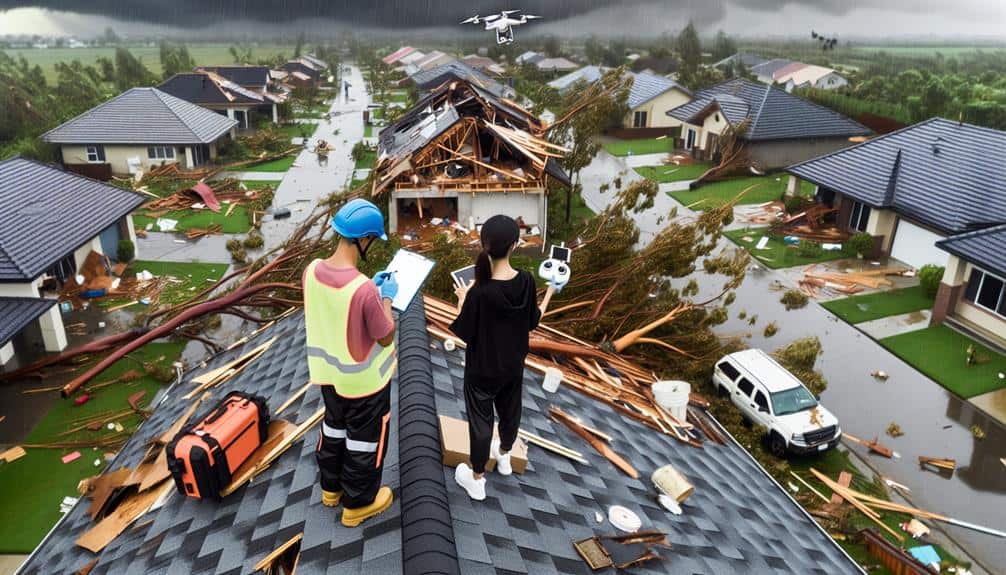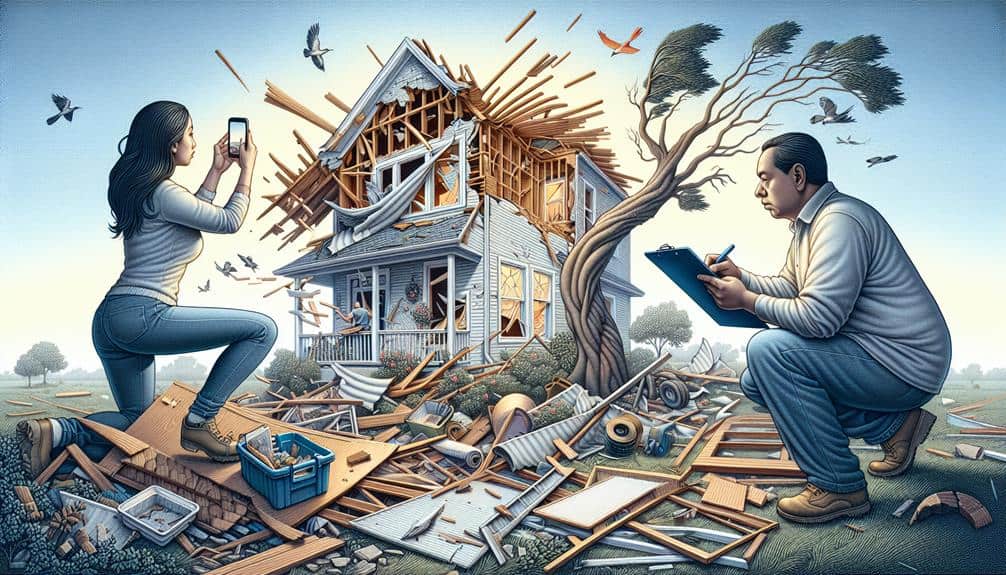To document storm damage for home renovation, we begin by examining safety risks and noting issues such as water ingress, shattered windows, and roof harm. We capture high-quality, wide-angle and close-up photos from various perspectives for a thorough view. Cataloging structural issues involves detailing and measuring fractures or water marks while using a notebook or app for precision. We gather detailed repair estimates from multiple contractors to guarantee cost-efficient solutions. Finally, we compile all documentation—photos, videos, and estimates—and submit it promptly to our insurance for streamlined claim processing. This approach will ensure we're well-equipped for successful renovations. Keep delving into expert tips and strategies.
Key Points
- Evaluate and document structural hazards such as downed power lines and water entry points.
- Capture clear, high-quality photos from multiple angles to document damage.
- Record detailed descriptions and measurements of visible damage to the foundation, walls, and roof.
- Obtain and compare multiple repair estimates from reputable contractors.
Assessing Damage Immediately
As soon as the storm passes, we should promptly inspect our home to identify and document any visible damage. Our first priority is evaluating safety; we need to make sure that there are no immediate hazards, like downed power lines, exposed wiring, or structural damage that could pose a risk.
If there's flooding, we'll want to check for water entering basements or crawl spaces, as this can compromise the foundation.
We should walk around both the exterior and interior of the house, making note of any broken windows, damaged roofing, or displaced siding. Documenting details is important at this stage. We need to jot down specific observations, such as the size of holes, the extent of water damage, and any visible cracks in the walls or foundation. These notes will be invaluable when we start planning repairs.
Inside the house, we should check ceilings and walls for leaks, which might not be immediately obvious. Look for any signs of moisture or discoloration. Let's also inspect our attic and basement, as these areas often show the first signs of structural issues. Being thorough now will save us time and money in the long run.
Photographing Affected Areas
Capturing clear, detailed photographs of the damage is crucial for both insurance claims and planning effective repairs. When we document the damage, we should focus on capturing high-quality images that clearly show the extent of the impact. This ensures that insurance adjusters and contractors have a thorough understanding of what needs to be repaired.
Here's how we can do it effectively:
- Wide-Angle Shots: Capture the entire affected area to provide context. For example, if lightning strikes have caused damage to the roof, take wide-angle shots of the roof and the surrounding structure to show the overall impact.
- Close-Up Details: Focus on specific damage points. For water damage, photograph areas where water has infiltrated walls, ceilings, or floors. Include close-ups of any visible mold or warping to highlight the severity.
- Multiple Angles: Take photos from different perspectives to give a 360-degree view of the damage. This is especially important for structural damage caused by lightning strikes or extensive water damage, as it helps in understanding the full scope.
Cataloging Structural Issues
When documenting structural issues, we should meticulously record each problem area to create a detailed log that will guide both contractors and insurance adjusters in their evaluations. Let's start by identifying all visible damage to the foundation, walls, roof, and any other critical structures. Detailed descriptions are essential—describe cracks, warping, water stains, and any signs of structural weakness.
Using a notebook or digital app, we can create a systematic record, noting the location and extent of each issue. We shouldn't overlook to measure and photograph these areas, providing clear evidence of the damage. Including a ruler or measuring tape in the photos helps to illustrate the scale.
Before/after comparisons will be invaluable. Taking 'before' photos as soon as possible after the storm makes certain we've a baseline to show the exact changes once repairs are complete.
This comparison not only helps contractors understand the scope of work but also fortifies our insurance claims.
Recording Repair Estimates
Now that we've documented the structural issues, let's gather detailed repair estimates from reputable contractors to guarantee we've accurate projections for the necessary work. Accurate estimates are essential to make sure we're not overspending and that repairs are done correctly.
To make sure we get the best possible quotes, we should follow these steps:
1. Provide Thorough Descriptions:
When contacting contractors, offer detailed descriptions of the damage. This includes photos, measurements, and any specific issues identified during our initial assessment. Thorough descriptions help contractors give precise estimates and avoid unexpected costs later on.
2. Seek Multiple Expert Opinions:
Don't settle for the first estimate. Reach out to at least three contractors to compare their approaches and pricing. Each contractor may see different aspects of the damage and suggest varied solutions, giving us a broader perspective on the necessary repairs.
3. Review and Compare Estimates:
Examine each estimate carefully. Look at the breakdown of labor, materials, and any additional costs. Make sure that all estimates are itemized and cover all identified damage. Comparing these estimates helps us find the most cost-effective and thorough solution.
Reporting to Insurance

Submitting our detailed documentation to the insurance company promptly guarantees we expedite the claims process and receive the compensation needed for our home renovation. First, we gather all our photos, videos, and repair estimates into an inclusive report. This report should clearly outline the extent of the storm damage and any immediate repairs we've already made to prevent further damage.
Next, we review our insurance policy to understand our coverage details. Knowing what our policy covers guarantees that we submit a claim that aligns with our entitlements. We should also note any specific requirements our insurer has for filing a claim, such as necessary forms or deadlines.
Contacting our insurance agent directly is another important step. We can ask for a detailed explanation of the claim process and any additional documents we might need. Having a clear line of communication ensures that we can swiftly address any issues or questions that arise.
Frequently Asked Questions
How Should I Store Documentation to Prevent Loss or Damage?
We should store our documentation in digital storage for easy access. To prevent loss or damage, let's use waterproof containers for physical copies. This way, we're ensuring our records are safe and readily available when needed.
Can I Use a Mobile App for Documenting Storm Damage?
Did you know 60% of homeowners lose paper documentation? Using a mobile app offers benefits like data security and easy access. We can document storm damage swiftly and securely, minimizing stress and ensuring freedom from paperwork hassles.
What Should I Do if I Discover Hidden Damage Later?
If we uncover concealed damage later, we should promptly notify our insurance company to update our claim. This will help make certain our insurance coverage extends to the new damage and keep our repair timeline on track.
Are There Specific Safety Precautions to Take While Documenting?
Just like knights don armor before battle, we should wear protective gear when documenting storm damage. Safety measures are important; make sure weather conditions are stable. Use video recording for thorough documentation, prioritizing our safety throughout.
How Long Should I Keep the Documentation Records?
We should keep the documentation records for a storage duration of at least five years. Let's make digital backups to safeguard our data, giving us the freedom to access and review it whenever needed.


